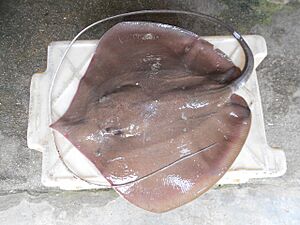Whitenose whipray facts for kids
Quick facts for kids Whitenose whipray |
|
|---|---|
 |
|
| Conservation status | |
| Scientific classification | |
| Genus: |
Pateobatis
|
| Species: |
uarnacoides
|
| Synonyms | |
|
|
The whitenose whipray (Pateobatis uarnacoides) is a type of stingray. It lives in the eastern Indian Ocean and the western central Pacific Ocean. You can find it in shallow waters, including places where rivers meet the sea, called estuaries.
This ray was first described in 1852 by a Dutch scientist named Pieter Bleeker. He was an army surgeon who spent 20 years in Indonesia. During that time, he collected over 12,000 fish specimens! He took them home to Holland, and most are now kept in the Natural History Museum in Leiden.
Where Do Whitenose Whiprays Live?
The whitenose whipray lives in the eastern Indian Ocean and the western central Pacific Ocean. Its home range stretches from India to Malaysia and Indonesia. This ray is a bottom-dwelling fish. This means it usually stays close to the seafloor.
You'll often find it over soft sandy or muddy areas. It prefers water that is shallower than 30 meters (about 100 feet). It can even be found in the lower parts of rivers and in estuaries. One whitenose whipray was even seen in a saltwater lagoon!
How Are Whitenose Whiprays Used?
People catch many whitenose whiprays using different fishing methods. These include bottom trawling, tangle netting, and Danish seine fishing. This happens a lot in India, Malaysia, and Indonesia.
The meat of the ray is eaten fresh or preserved. It can be salted and dried for later use. The cartilage, which is like the bones, is also dried. It is then sent to countries in the Far East. The skins of these rays are also used. They are dried and made into special leather called galuchat. This leather is used to make bags, wallets, belts, and shoes.
Why Is This Ray Endangered?
The whitenose whipray is in trouble because too many are being caught. This is called overexploitation. People are fishing for them very intensely across most of their habitat.
In Indonesia, fishing boats now have to travel much farther to find enough rays. In India, where a lot of these rays are caught, the number of fish caught is also going down. This is due to too much fishing, as well as pollution and damage to coastal areas. Because of these problems, the International Union for Conservation of Nature has listed the whitenose whipray as "endangered." This means it is at a high risk of disappearing forever.


